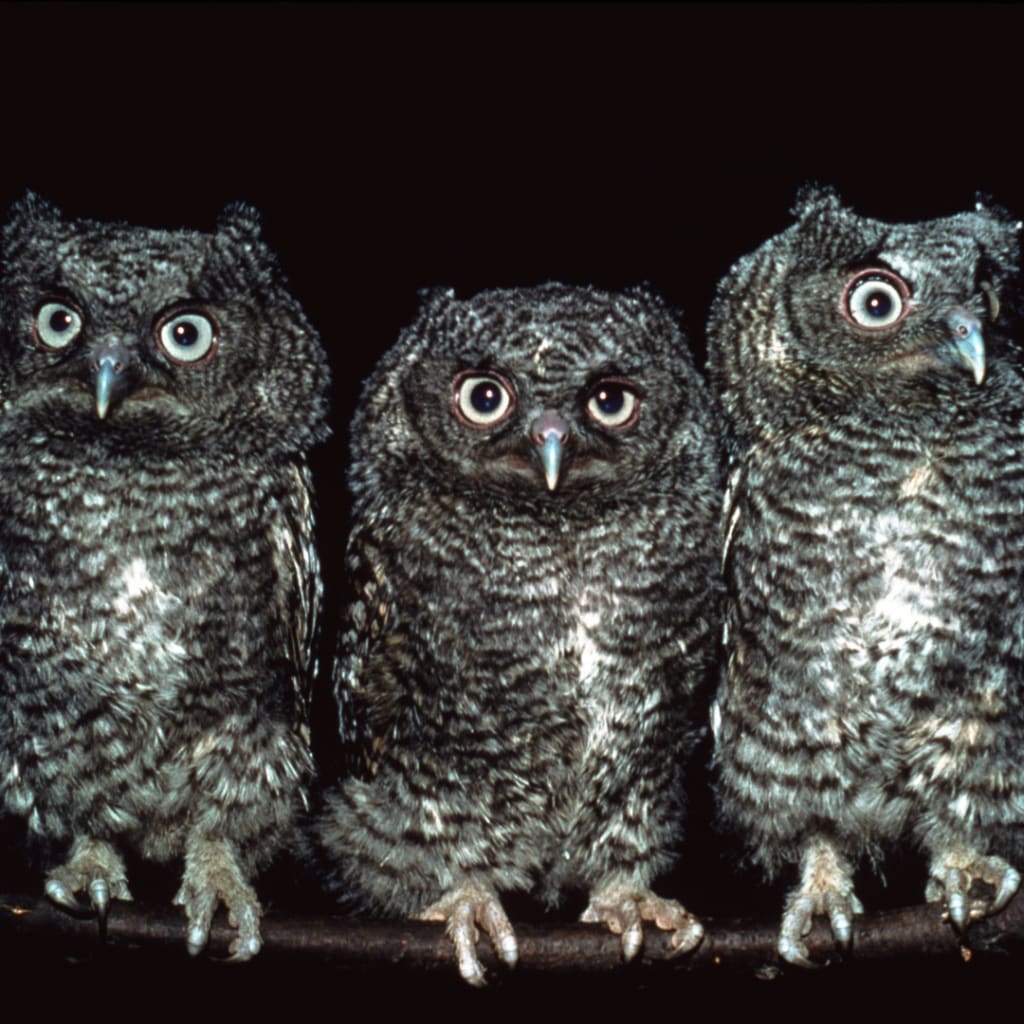
In the bird world, the Corvidae family are definitely the scholars of their kind. They are trainable problem-solvers. Researchers have been amazed by the brain-power these birds possess. When it comes to the Corvidae family, there isn’t much scientist can’t agree on. However, there is one bird whoo’s evolutionary timeline and behavior has sparked a little debate. Whoo is this mystique feathered friend that challenge researchers? The Owl, of course.
The evolution of the owl is riveting, but many aspects of it are highly debated by researchers. Fossilized evidence has indicated that the owl species is at least 54 million years old. Which makes them one of the oldest known non-galloanserae land birds. The actual number of species is still being debated, but scientists estimate there are roughly 150-220 species of owls. These species can be divided up into two families: The Strigidae family of true (or typical) owls and the Tytonidae family of barn-owls. Like most birds’ owls primarily focus on food, shelter and protecting their young. However, it is their unique ability to carry out these affairs that set them apart. They are indigenous to every continent except Antarctica. Over the course of evolution, owls have become exceptionally good at adapting to environmental changes. For example, out of all the North American raptors, owls have the most diverse diets. This allows them to stay put while most other birds need to migrate to find food.
Owls eat everything from dung beetles and scorpions to crows and osprey. Some owls, such as the Great Horned Owl, will even add smaller owls to the menu. Making them the Jeffery Dahmer of their own species. With a reputation like that it is no surprise that owls occasionally receive a little public backlash. While burning the midnight oil, flocks of crows have been reportedly known to harass owls for hours. When the owl attempts to escape the harassment, the angry mob of crows follow the owl. Despite all the protesting these owls don’t seem to give a hoot and remain one of the crows most dangerous predators. While most of the owls hunting strategies are pretty straight forward, the burrowing owl uses a little more non-conventional technique to put food on the table. Burrowing-owls are part of a small percentage of owls that hunt during the day. David Levey, an ornithologist from Florida, did a study on the unique behavior of the burrowing-owl. He observed how the burrowing owls used poop to lure in their prey. Seriously! You can’t make this crap up! The burrowing owl has no preference to the kind of poop he uses and decorates the outside of his home with. The poop is used to attract dung beetles that the owl eats. Although stealing another animal’s poop to catch dinner is odd, it’s not the only thing Owls take from other animals.
Owls differ from other birds because they do not make their own nests. Instead, they use nests that have been abandoned by other animals. As the saying goes “Finders keepers, loser’s weepers”. Even after an owl has claimed residency to an abandon nest they make little to no changes to the nest. When an owl has babies, 2-4 eggs average, the owlets remain in the nest with their parents for 6-9weeks. While other baby birds fight over the food their mother brings, owlets do not. This is because adult owls feed their oldest and strongest owlet first; Making competition among siblings nonexistent. Most owls are strictly monogamous. However, female barn-owls (Tytonidae family; Tyto alba) often desert their young to search for another male to have a second annual batch of young with. Some studies suggest that the females are just hardwired to think this way and can’t help their promiscuous ways. Speaking of myths have you heard the one about the owl?
The portrayal of owls has varied with each culture, symbolized many things, and is featured in a number of different folklores. For many people the owl is a symbol of wisdom. The legend of the “wise old owl” more than likely originated from ancient Greek mythology and the Goddess of Wisdom, Athena. As the story goes… Athena was always either accompanied by an owl or represented by one. It is because of the owl’s association with the Goddess of Wisdom, that people began to believe the owl was wise. In contrast, many other cultures associated owls with death and evil. While some native Americans saw them as protective spirits or souls of the recently deceased that deserved respect; other tribes believed owls were a bad omen. In Roman mythology hearing the hoot of an owl indicated imminent death. It was even believed that an owl actually predicted the death of Julius Caesar. Apparently in his youth, the grim reaper collaborated with the owls on pending business transactions. Owl folklore and mythology is vast but multiple studies have been done that could debunk most if not all of them. For example, owls rank relatively low on an intellectual scale when compared to other brainy birds, such as the crow or parrot. If not done during their earlier stages of life owls are borderline untrainable. Owls may not have the brain power to pass a test. But what they do have are a very particular set of skills; skills they have acquired throughout evolution. Skills that make them a nightmare for the animals they pursue.
Owls are natural born hunters. The owl is so genetically equipped for the hunt that even the government requires them to get a hunting permit. On the battlefield, these mystique creatures of the night are complete savages. An owl’s talons are particularly impressive. They use their incredible grip strength to sever the spines of larger prey. Jeez! Talk about a tough break! It estimated that it takes anywhere from 300-3000 pounds of pressure per square inch (PSI) to break the grip of an owl’s talons. They are 5 to 54 times stronger than the average grip strength of an adult man. Although most animals try to avoid being hunted, the owl is capable of getting inches from its’ prey before it is detected. Owls are known as the silent predator. They have special feathers that help reduce noise making them nearly silent fliers; They are like little spies on a deadly mission. Still not impressed? Owls also have binocular vision, but their eyes are fixed in their sockets. Instead of eyeballs owls have eye tubes. Their eyes are elongated “tubes” that are held in place by sclerotic rings. Since their eyes are tubular, owls cannot roll or move their eyes. The lack of eye movement does not necessarily pose an issue because they are capable of turning their heads 270 degrees (135 degrees in either direction). They also have impeccable night vision. Their night vision is the best in the animal kingdom. In addition to having great sight, owls have also been gifted with super hearing. They can hear their prey moving through 2 feet of snow or dirt. You can run, but you can’t hide from an owl. While evolution may have played a role in the fascinating abilities of today’s owl scientists still can’t agree on how much the owl has actually evolved.
Regardless of where they came from, how long they have existed, or how many species there are the owl is a fascinating bird with impressive physical traits. The reason owls are so compelling is because there is much more about them to be discovered! Plus, whoo doesn’t love a good mystery?
** Interesting Theory: Instead of hooting, barn-owls make screeching calls. The barn-owl’s screech sounds like a screaming banshee. In Irish mythology, the screaming banshee is said to have been able to predict a person’s death. I’m not saying that owls can or cannot predict death, but there are some similarities between the barn-owls screech, the Irish screaming banshee folklore and the Romans mythology on owls – It makes you wonder.
Britney Draper
About the Creator
Britney Draper
I started this account to share all my old college papers. I figure, what goods a paper if I'm the only one that reads it? I enjoy writing. Maybe you'll enjoy my writing too.






Comments
There are no comments for this story
Be the first to respond and start the conversation.